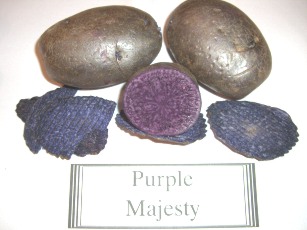
- Shape: Oblong
- Skin: purple
- Flesh: purple
- Market Use: Specialty Markets
- Medium Maturing
 |
Characteristics
|
Plant/roots This cultivar is fast emerging with a medium vine and purple flower. Purple Majesty has a determinate growth habit and a moderate concentrated root system.
Tubers are deep purple fleshed, oval to oblong and smooth with a purple skin color; eyes are shallow and well distributed; Medium specific gravity - 1.083.
Yields potential 400 to 450 cwt. range. It has a smaller tuber size profile and averages around 70% U.S. #1's
Fertility (soil test basis; lbs/acre)
Apply total fertilizer in the following range: N(l70-190#), P( 80-200#), K(O-60#). Performance in alkaline soils is good. Pre-plant incorporated N should be from 80 to 100#. Early season N applications do not adversely affect the timing of tuberization. Sprinkler applied N should be in the 30 to 90# range at a rate of 20# per application. Don't apply nitrogen too late for good skin set.Irrigation
Irrigation interval at the maximum ET is 3 days. Drought tolerance is good. Water use drops dramatically during vine maturation, Water use drops dramatically during vine maturation, so careful monitoring is essential to prevent late season overwatering that will hasten the plants death, but won't usually lead to leak problems.
Pest control
Weeds Competition against weeds is is moderate so goo weed control is essential. Purple Majesty is tolerant to metribuzin.Insects: Standard insect control measures generally are effective.
Fungicides Control of foliar early blight usually requires two to four fungicide applications in SLV of Colorado.
Tuber/bulking Tuber set is often heavy and small tuber size can result. Tuberization occurs early and tubers bulk at a moderate rate thoughout the season. Tubers are resistant to secondary growth and shatter bruises and moderately resistant to hollow heart.
Vine kill ine kill Average days from planting to vine kill are 100. Vine killing is not always required in most years and if needed can be easily accomplished once mature. Adequate skin set occurs within 21 days. Tubers Tubers do not have much problems with shatter bruise, but can be injured easily so care should be taken in handling. An oxidant or control for fusarium dry rot should be applied at harvest.
| Field | Storage |
| Foliar early blight: Moderately susceptible | Tuber early blight Resistant |
| Verticillium wilt: Moderate | Bacterial soft rot Moderately resistant |
| Blackleg Susceptible | Fusarium dry rot Susceptible |
| Seedpiece decay Susceptible | Leak (Pythium) Moderate |
| Leafroll virus Resistant | Pink rot (Phytophthora) Moderate |
| Leafroll Net necrosis Resistant | Silver scurf Moderately Resistant |
| PVY, PVX Moderately resistant | Rhizoctonia scurf Resistant |
| Bacterial ring rot Moderate | Common Scab Susceptable |
| Powdery Scab Moderately resistant |
Disease reaction ratings susceptible, moderately susceptible, moderate, moderately resistant and resistant.
Note: This information should only be used as a guide. Adjustments for local conditions must always be made.